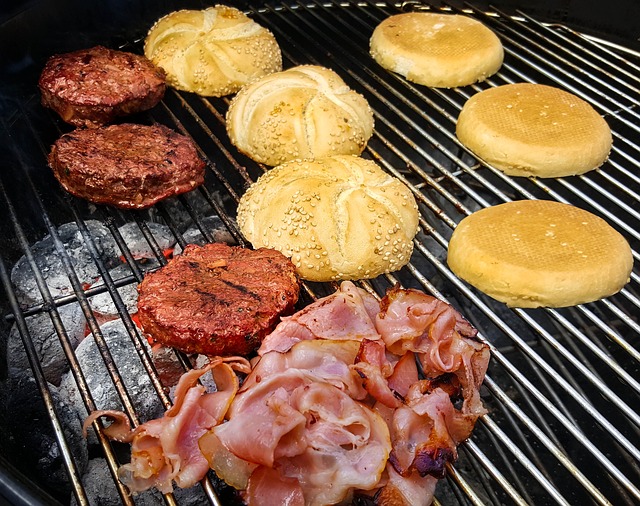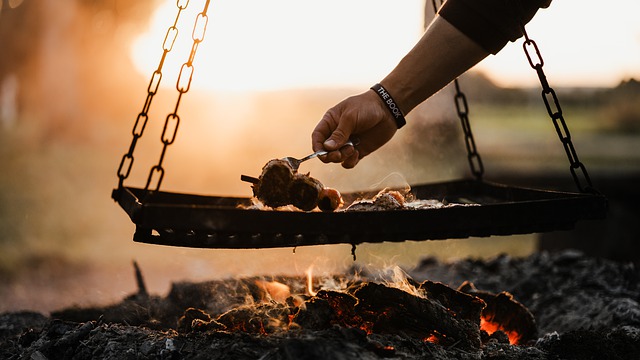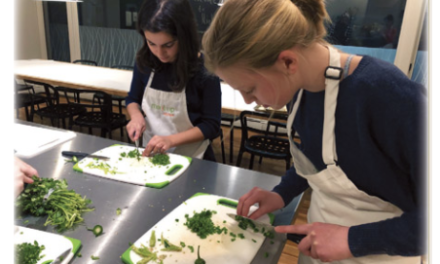
A Guy, A Burger, A Beer. A food safety story.
Imagine you’re at a holiday barbeque (yes you can do this now!). The sun is shining. The flowers are blooming. The beer is flowing. The temperature is rising. It’s gonna be a scorcher. Your host runs inside, grabs a platter, and attacks the package of thawing hamburger meat on the counter. In a hurry to make patties, he doesn’t see the hamburger juices oozing onto the counter. After all, people are hungry. The phone rings. He coughs into his hand to clear his throat as he picks up the phone.
During the ten-minute conversation, he pulls a cold beer and a few tomatoes from the fridge. Multitasking is essential for a successful barbecue. With the patties made, he starts on the tomatoes, unconsciously nudging slices off the breadboard and onto the hamburger ooze. Just as he’s off the phone, another guest beckons to him from outside. He’s up—horseshoes. The screen door slams behind him. The burgers and tomatoes co-exist, uncovered in the empty kitchen, the mercury surpassing 90 degrees.
Forty-five minutes and two beers later, he comes inside to grab the burgers. Out to the grill, he goes. He coughs again, takes a swig of beer, and throws the burgers on the grill by hand. He cooks the patties while finishing his beer and doing a shot of tequila. Eying the burgers, he thinks they must be done and returns them to the original platter.
While guests grab burgers, replete with contaminated tomatoes, he’s tapping a new keg, setting up badminton, and, in general, is a very attentive host. So attentive, that he finally eats his burger over an hour later. He is not known to be an unsanitary person. He is just caught up in the moment. And we wonder why hear so many stories about food contamination.
Food Safety
Every year in the United States, 48 million people get gastrointestinal illnesses from foodborne diseases. Of these, 128,00 are hospitalized and 3,000 people die. Huge numbers—with many more cases going unreported. As the weather heats up, so do outbreaks of foodborne illness. More people spend time on outdoor eating activities in warmer, bacteria-nurturing temperatures, and in environments outside their kitchens, making it harder to control food safety.

Burgers awaiting the grill.
When it comes to safe food handling though, knowledge and forethought really are power—they can prevent bacterial growth and ultimately foodborne illness. For the consumer, the process starts when he or she purchases raw meat or poultry. Whether at the supermarket or a local farm or farmers’ market, buy your perishable items last. And don’t run a million errands in your car with your perishables practically self-cooking in the back seat. Refrigerate these foods within two hours of purchase; if the temperature is 90 degrees or above, your window shrinks to one hour. Once at home, the USDA recommends “placing meat and poultry in the refrigerator immediately. Freeze poultry and ground meat that won’t be used in 1 or 2 days; freeze other meat within 4 to 5 days.”
When thawing meats or poultry, go for a slow, safe thaw in the refrigerator, or thaw the product in a sealed package in cold water, ensuring that its internal temperature stays under 40 degrees. Open-air thawing causes any bacteria that may have been present before freezing to multiply quickly. Only use a microwave to defrost if it’s going immediately to the grill. And if you’re going to partially cook the product, transfer it without delay to the grill or the oven.
If you use a marinade, allow food to marinate in the refrigerator, not on the counter. Reserve a portion for sauce, if desired, before you pour the marinade over meat or poultry. If you have to reuse the marinade you’ve poured over raw meat, use a separate pan to bring it to a boil first. This will eliminate harmful bacteria.
Experts from various agencies, including the USDA, FDA, MA Department of Health, Center for Disease Control, and the Organic Trade Association all agree that there are simple steps that can help prevent harmful bacteria from making your family and friends sick. Incorporating these guidelines into all your summer dining activities will eliminate trips to the emergency room and could save lives, especially for those with weakened immune systems.

Burgers on the grill.
Food handling safety risks at home are more common than most people think.
1. Clean: Wash Hands and Surfaces Often. Wash hands, utensils, plates, and cutting boards before and after contact with raw meat, poultry, seafood, and eggs.
2. Separate: Don’t Cross-Contaminate. Cross-contamination during the preparation, grilling, and serving of food is a prime cause of foodborne illness. Keep raw meat, poultry, and seafood apart from foods that won’t be cooked.
3. Cook: Cook to Proper Temperatures. Use a food thermometer—you can’t tell if food is cooked safely by how it looks.
4. Chill: Refrigerate Promptly. Holding food at an unsafe temperature is a prime cause of foodborne illness. Refrigerate leftovers and take-out foods within 2 hours and keep the fridge at 40 °F or below.
Source: FDA and FSIS/USDA
So, let’s retrace the steps of our grill master and count how many times he entered the safe food danger zone.
Hmmm…all totaled, our host made 10 safe food handling gaffes including an improper thawing; a quintuple cross-contamination—ground beef hands to cough to phone to refrigerator door to tomatoes to ground beef; two temperature infractions that increased bacterial growth exponentially; and potentially undercooked burgers—after all the other missteps, our host missed his last chance to cook all the bacteria out of the burgers. With a little more preparation, our host could cultivate safe food-handling habits that are simple enough to implement and would not deter him from his other entertaining duties.
Bottom line: isn’t the safety of your family and friends the real priority?
First and foremost, wash your hands, as well as food-contact surfaces, with hot soapy water. This includes cutting boards, utensils, and countertops. These items are a breeding ground for cross-contamination. In the world of safe food handling, cleanliness really is next to godliness. Your gastrointestinal system will thank you, as will your family and guests.
Secondly, if you are not going to grill the product immediately, cover it and return it to the refrigerator. Separate it from other products and double-check that the raw meat juices are contained just to the platter.
According to USDA and many food experts, food is “safely cooked when it is heated for a long enough time and at a high enough temperature to kill harmful bacteria that cause foodborne illness.” Because you cannot see if a product is contaminated, it is very important to use a food thermometer. USDA recommends meat must be cooked to the following internal temperatures. If the juices are still running blood, you are putting yourself and your loved ones at risk.
SAFE MINIMUM INTERNAL TEMPERATURES
Poultry: whole, breasts, ground: 165 °F
Hamburgers, beef: 160 °F
Beef, veal, and lamb (steaks, roasts, and chops): Medium rare 145 °F, Medium 160 °F
All cuts of pork: 160 °F
Do not, do not, do not put the cooked meats or poultry back on the platter that you brought out to the grill. All the work you did cooking your hamburger to a safe temperature goes out the door when you place the cooked product back on the platter that held the raw meat. One of the leading reasons for foodborne illnesses is cross-contamination.
Once the burgers are safely cooked, keep them to the side of the grill or in the oven at 200 degrees until ready to eat. Refrigerate leftovers within two hours or one hour if the temperature is over 90 degrees.
What about Grass-fed, natural, and organic meat products? While this type of farming minimizes diseases for the animal, once the consumer purchases the product, the same safe food handling guidelines apply.
Now to be fair, our host could have been a man or a woman, and I was not trying to slight the opposite sex. We all can improve our safe food handling efforts, especially in a hectic, overscheduled world. This new vigilance is a far cry from the days when my mother snuck me pieces of salted, raw hamburger meat as a treat. But it all changed for me when my good friend, former supermarket colleague, and safe food handling maven, David Small, told me how foodborne illness was contracted. And the story he used…you’re at a Summer Barbecue.

Custom Barbeque.







